Похожие презентации:
Single-row functions
1. Single-Row Functions
3Single-Row Functions
2. Objectives
After completing this lesson, you shouldbe able to do the following:
• Describe various types of functions
available in SQL
• Use character, number, and date
functions in SELECT statements
• Describe the use of conversion
functions
3-2
3. SQL Functions
InputFunction
arg 1
arg 2
arg n
3-3
Output
Function
performs action
Result
value
4. Two Types of SQL Functions
FunctionsSingle-row
functions
3-4
Multiple-row
functions
5. Single-Row Functions
• Manipulate data items• Accept arguments and return one value
• Act on each row returned
• Return one result per row
• May modify the datatype
• Can be nested
function_name (column|expression, [arg1, arg2,...])
3-5
6. Single-Row Functions
CharacterGeneral
Conversion
3-6
Single-row
functions
Number
Date
7. Character Functions
Characterfunctions
Case conversion
functions
LOWER
UPPER
INITCAP
Character manipulation
functions
CONCAT
SUBSTR
LENGTH
INSTR
LPAD
3-7
8. Case Conversion Functions
Convert case for character stringsFunction
Result
LOWER('SQL Course') sql course
UPPER('SQL Course')
SQL COURSE
INITCAP('SQL Course') Sql Course
3-8
9. Using Case Conversion Functions
Display the employee number, name, anddepartment number for employee Blake.
SQL> SELECT empno, ename, deptno
2 FROM
emp
3 WHERE
ename = 'blake';
no rows selected
SQL> SELECT
2 FROM
3 WHERE
empno, ename, deptno
emp
LOWER(ename) = 'blake';
EMPNO ENAME
DEPTNO
--------- ---------- --------7698 BLAKE
30
3-9
10. Character Manipulation Functions
Manipulate character stringsFunction
Result
CONCAT('Good', 'String') GoodString
SUBSTR('String',1,3)
Str
LENGTH('String')
6
INSTR('String', 'r')
3
LPAD(sal,10,'*')
******5000
3-10
11. Using the Character Manipulation Functions
SQL> SELECT ename, CONCAT (ename, job), LENGTH(ename),2
INSTR(ename, 'A')
3 FROM
emp
4 WHERE SUBSTR(job,1,5) = 'SALES';
ENAME
---------MARTIN
ALLEN
TURNER
WARD
3-11
CONCAT(ENAME,JOB)
LENGTH(ENAME) INSTR(ENAME,'A')
------------------- ------------- ---------------MARTINSALESMAN
6
2
ALLENSALESMAN
5
1
TURNERSALESMAN
6
0
WARDSALESMAN
4
2
12. Number Functions
• ROUND:Rounds value to specified
decimal
ROUND(45.926, 2)
• TRUNC:
Truncates value to specified
decimal
TRUNC(45.926, 2)
• MOD:
45.92
Returns remainder of division
MOD(1600, 300)
3-12
45.93
100
13. Using the ROUND Function
SQL> SELECT ROUND(45.923,2), ROUND(45.923,0),2
ROUND(45.923,-1)
3 FROM
DUAL;
ROUND(45.923,2) ROUND(45.923,0) ROUND(45.923,-1)
--------------- -------------- ----------------45.92
46
50
3-13
14. Using the TRUNC Function
SQL> SELECT TRUNC(45.923,2), TRUNC(45.923),2
TRUNC(45.923,-1)
3 FROM
DUAL;
TRUNC(45.923,2) TRUNC(45.923) TRUNC(45.923,-1)
--------------- ------------- --------------45.92
45
40
3-14
15. Using the MOD Function
Calculate the remainder of the ratio ofsalary to commission for all employees
whose job title is a salesman.
SQL> SELECT
2 FROM
3 WHERE
ename, sal, comm, MOD(sal, comm)
emp
job = 'SALESMAN';
ENAME
SAL
COMM MOD(SAL,COMM)
---------- --------- --------- ------------MARTIN
1250
1400
1250
ALLEN
1600
300
100
TURNER
1500
0
1500
WARD
1250
500
250
3-15
16. Working with Dates
• Oracle stores dates in an internalnumeric format: Century, year, month,
day, hours, minutes, seconds.
• The default date format is DD-MON-YY.
• SYSDATE is a function returning date
and time.
• DUAL is a dummy table used to view
SYSDATE.
3-16
17. Arithmetic with Dates
• Add or subtract a number to or from adate for a resultant date value.
• Subtract two dates to find the number of
days between those dates.
• Add hours to a date by dividing the
number of hours by 24.
3-17
18. Using Arithmetic Operators with Dates
SQL> SELECT ename, (SYSDATE-hiredate)/7 WEEKS2 FROM
emp
3 WHERE deptno = 10;
ENAME
---------KING
CLARK
MILLER
3-18
WEEKS
--------830.93709
853.93709
821.36566
19. Date Functions
3-19FUNCTION
DESCRIPTION
MONTHS_BETWEEN
Number of months
between two dates
ADD_MONTHS
Add calendar months to
date
NEXT_DAY
Next day of the date
specified
LAST_DAY
Last day of the month
ROUND
Round date
TRUNC
Truncate date
20. Using Date Functions
• MONTHS_BETWEEN ('01-SEP-95','11-JAN-94')19.6774194
• ADD_MONTHS ('11-JAN-94',6)
'11-JUL-94'
• NEXT_DAY ('01-SEP-95','FRIDAY')
'08-SEP-95'
• LAST_DAY('01-SEP-95')
'30-SEP-95'
3-20
21. Using Date Functions
• ROUND('25-JUL-95','MONTH')01-AUG-95
• ROUND('25-JUL-95','YEAR')
01-JAN-96
• TRUNC('25-JUL-95','MONTH')
01-JUL-95
• TRUNC('25-JUL-95','YEAR')
01-JAN-95
3-21
22. Conversion Functions
Datatypeconversion
Implicit datatype
conversion
3-22
Explicit datatype
conversion
23. Implicit Datatype Conversion
For assignments, Oracle can automaticallyconvert
From
To
VARCHAR2 or CHAR
NUMBER
VARCHAR2 or CHAR
DATE
NUMBER
VARCHAR2
DATE
VARCHAR2
3-23
24. Implicit Datatype Conversion
For expression evaluation, Oracle canautomatically convert
From
To
VARCHAR2 or CHAR
NUMBER
VARCHAR2 or CHAR
DATE
3-24
25. Explicit Datatype Conversion
TO_NUMBERNUMBER
TO_CHAR
3-25
TO_DATE
CHARACTER
TO_CHAR
DATE
26. TO_CHAR Function with Dates
TO_CHAR(date, 'fmt')The format model:
• Must be enclosed in single quotation marks
and is case sensitive
• Can include any valid date format element
• Has an fm element to remove padded
blanks or suppress leading zeros
• Is separated from the date value by a
comma
3-26
27. Date Format Model Elements
YYYYFull year in numbers
YEAR
Year spelled out
MM
2-digit value for month
MONTH
Full name of the month
DY
3-letter abbreviation of the day
of the week
DAY
Full name of the day
3-27
28. Date Format Model Elements
• Time elements format the time portion ofthe date.
HH24:MI:SS AM
15:45:32 PM
• Add character strings by enclosing them
in double quotation marks.
DD "of" MONTH
12 of OCTOBER
• Number suffixes spell out numbers.
ddspth
3-28
fourteenth
29. Using TO_CHAR Function with Dates
SQL> SELECT ename,2
TO_CHAR(hiredate, 'fmDD Month YYYY') HIREDATE
3 FROM
emp;
ENAME
HIREDATE
---------- ----------------KING
17 November 1981
BLAKE
1 May 1981
CLARK
9 June 1981
JONES
2 April 1981
MARTIN
28 September 1981
ALLEN
20 February 1981
...
14 rows selected.
3-29
30. TO_CHAR Function with Numbers
TO_CHAR(number, 'fmt')Use these formats with the TO_CHAR
function to display a number value as a
character.
3-30
9
0
Represents a number
Forces a zero to be displayed
$
Places a floating dollar sign
L
.
,
Uses the floating local currency symbol
Prints a decimal point
Prints a thousand indicator
31. Using TO_CHAR Function with Numbers
SQL> SELECT2 FROM
3 WHERE
SALARY
-------$3,000
3-31
TO_CHAR(sal,'$99,999') SALARY
emp
ename = 'SCOTT';
32. TO_NUMBER and TO_DATE Functions
• Convert a character string to a numberformat using the TO_NUMBER function
TO_NUMBER(char)
• Convert a character string to a date
format using the TO_DATE function
TO_DATE(char[, 'fmt'])
3-32
33. RR Date Format
Current Year1995
1995
2001
2001
Specified Date
27-OCT-95
27-OCT-17
27-OCT-17
27-OCT-95
RR Format
1995
2017
2017
1995
YY Format
1995
1917
2017
2095
If the specified two-digit year is
0-49
If two digits
of the
current
year are
3-33
0-49
The return date is in
the current century.
50-99
The return date is in
the century after
the current one.
50-99
The return date is in
the century before
the current one.
The return date is in
the current century.
34. NVL Function
Converts null to an actual value• Datatypes that can be used are date,
character, and number.
• Datatypes must match
– NVL(comm,0)
– NVL(hiredate,'01-JAN-97')
– NVL(job,'No Job Yet')
3-34
35. Using the NVL Function
SQL> SELECT ename, sal, comm, (sal*12)+NVL(comm,0)2 FROM
emp;
ENAME
SAL
COMM (SAL*12)+NVL(COMM,0)
---------- --------- --------- -------------------KING
5000
60000
BLAKE
2850
34200
CLARK
2450
29400
JONES
2975
35700
MARTIN
1250
1400
16400
ALLEN
1600
300
19500
...
14 rows selected.
3-35
36. DECODE Function
Facilitates conditional inquiries by doingthe work of a CASE or IF-THEN-ELSE
statement
DECODE(col/expression, search1, result1
[, search2, result2,...,]
[, default])
3-36
37. Using the DECODE Function
SQL> SELECT job, sal,2
DECODE(job, 'ANALYST', SAL*1.1,
3
'CLERK',
SAL*1.15,
4
'MANAGER', SAL*1.20,
5
SAL)
6
REVISED_SALARY
7 FROM
emp;
JOB
SAL REVISED_SALARY
--------- --------- -------------PRESIDENT
5000
5000
MANAGER
2850
3420
MANAGER
2450
2940
...
14 rows selected.
3-37
38. Nesting Functions
• Single-row functions can be nested toany level.
• Nested functions are evaluated from
deepest level to the least deep level.
F3(F2(F1(col,arg1),arg2),arg3)
Step 1 = Result 1
Step 2 = Result 2
Step 3 = Result 3
3-38
39. Nesting Functions
SQL> SELECT2
3 FROM
4 WHERE
ename,
NVL(TO_CHAR(mgr),'No Manager')
emp
mgr IS NULL;
ENAME
NVL(TO_CHAR(MGR),'NOMANAGER')
---------- ----------------------------KING
No Manager
3-39
40. Summary
Use functions to:• Perform calculations on data
• Modify individual data items
• Manipulate output for groups of rows
• Alter date formats for display
• Convert column datatypes
3-40
41. Practice Overview
• Creating queries that require the use ofnumeric, character, and date functions
• Using concatenation with functions
• Writing case-insensitive queries to test
the usefulness of character functions
• Performing calculations of years and
months of service for an employee
• Determining the review date for an
employee
3-41
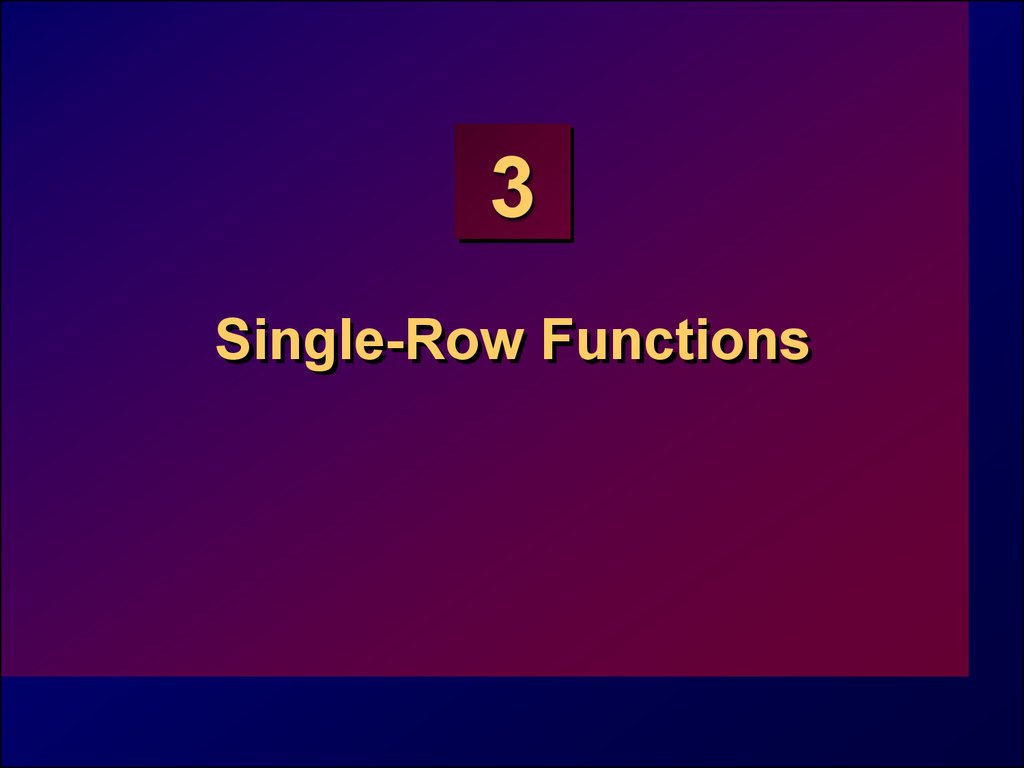

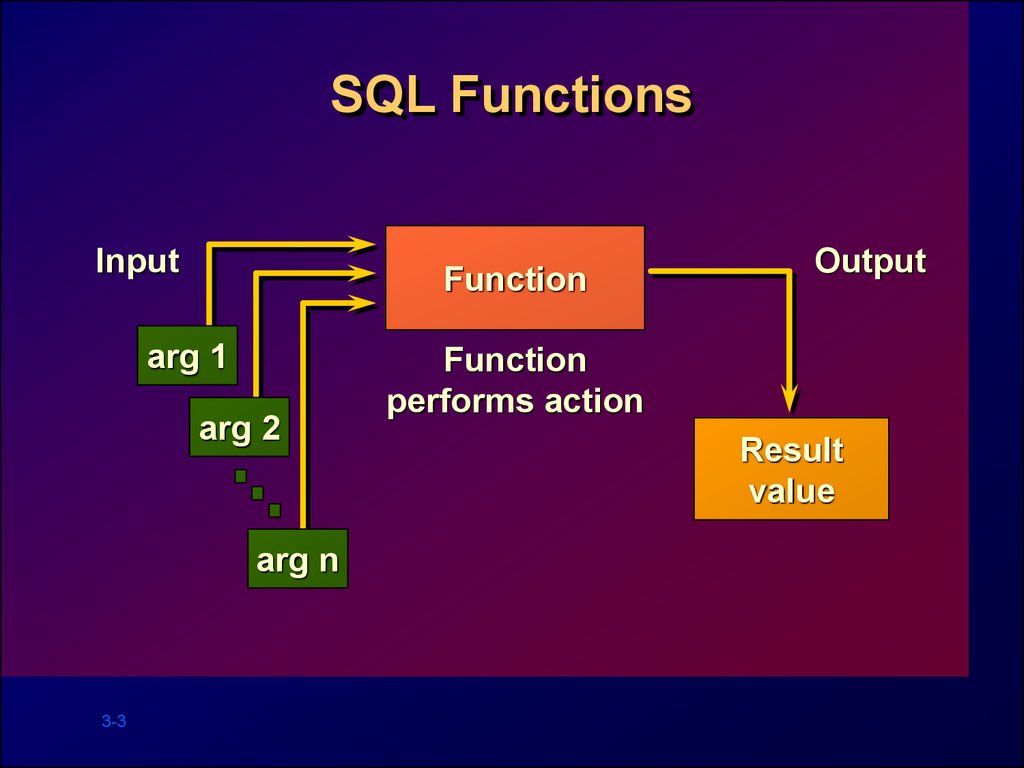


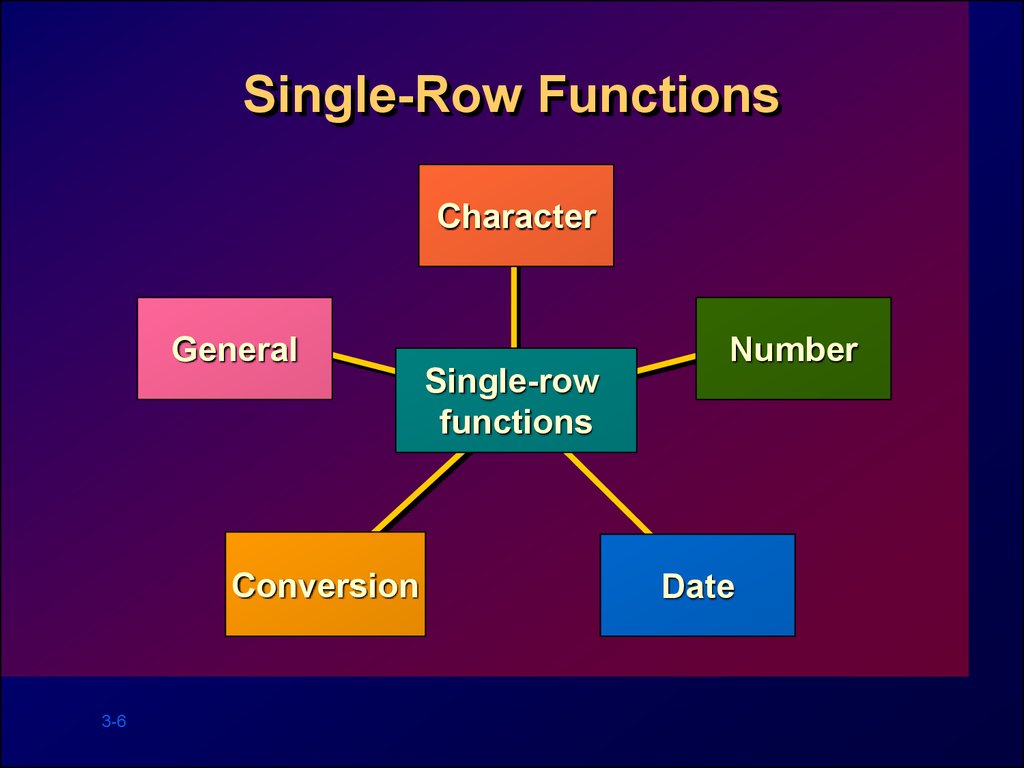
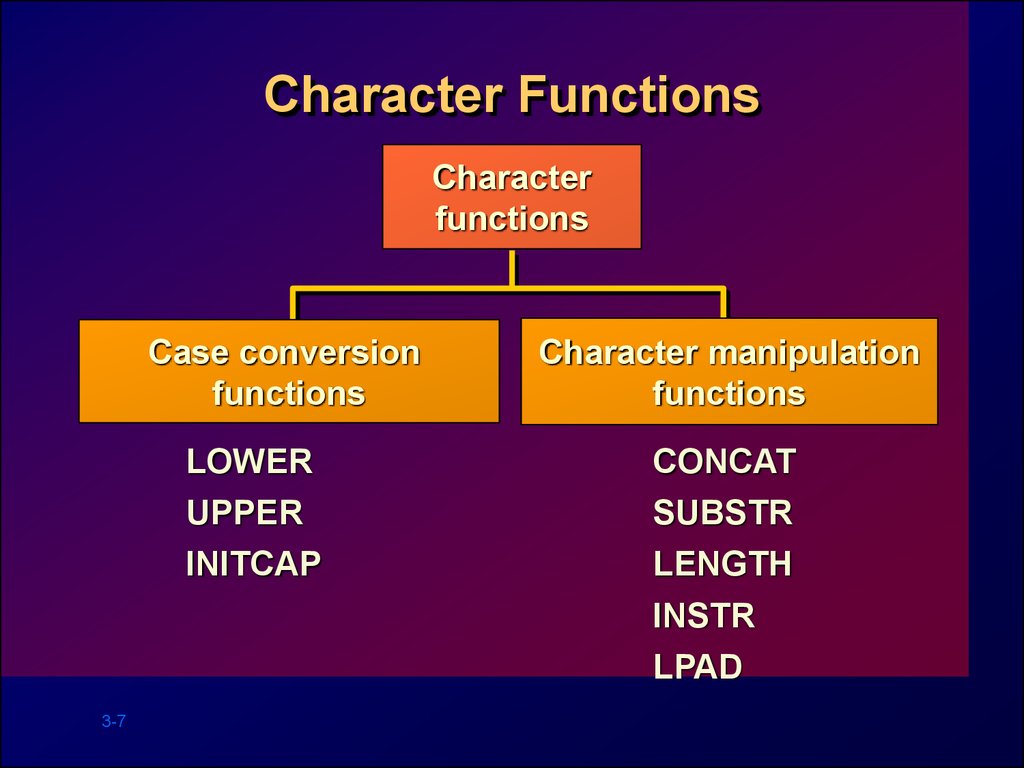
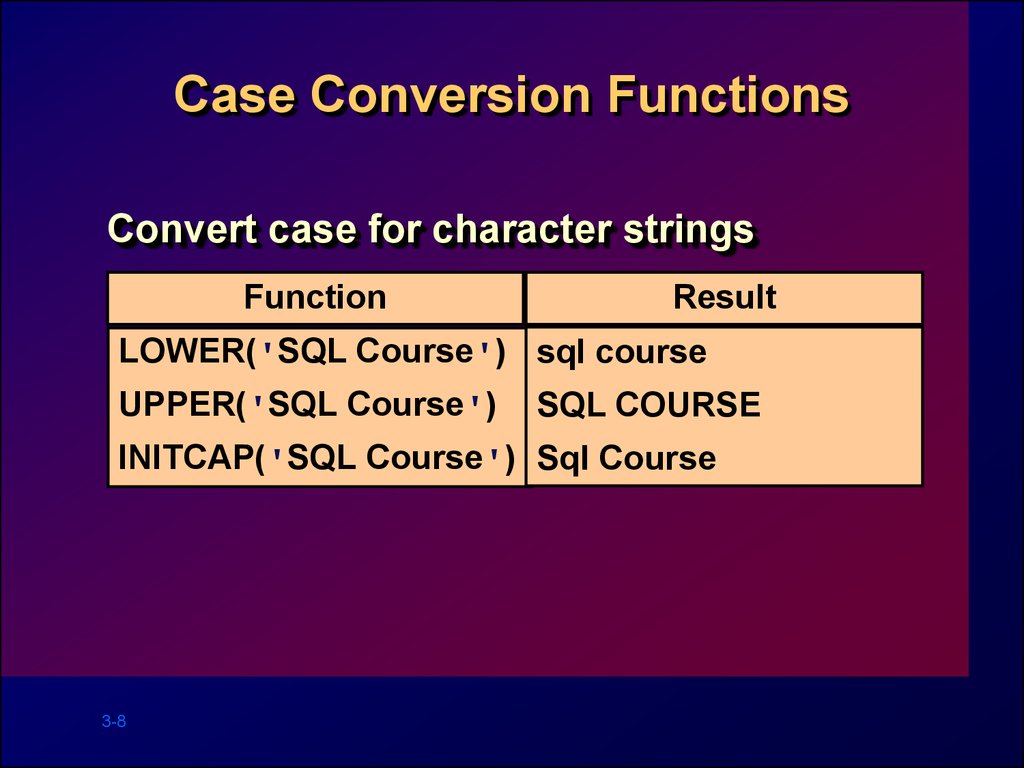
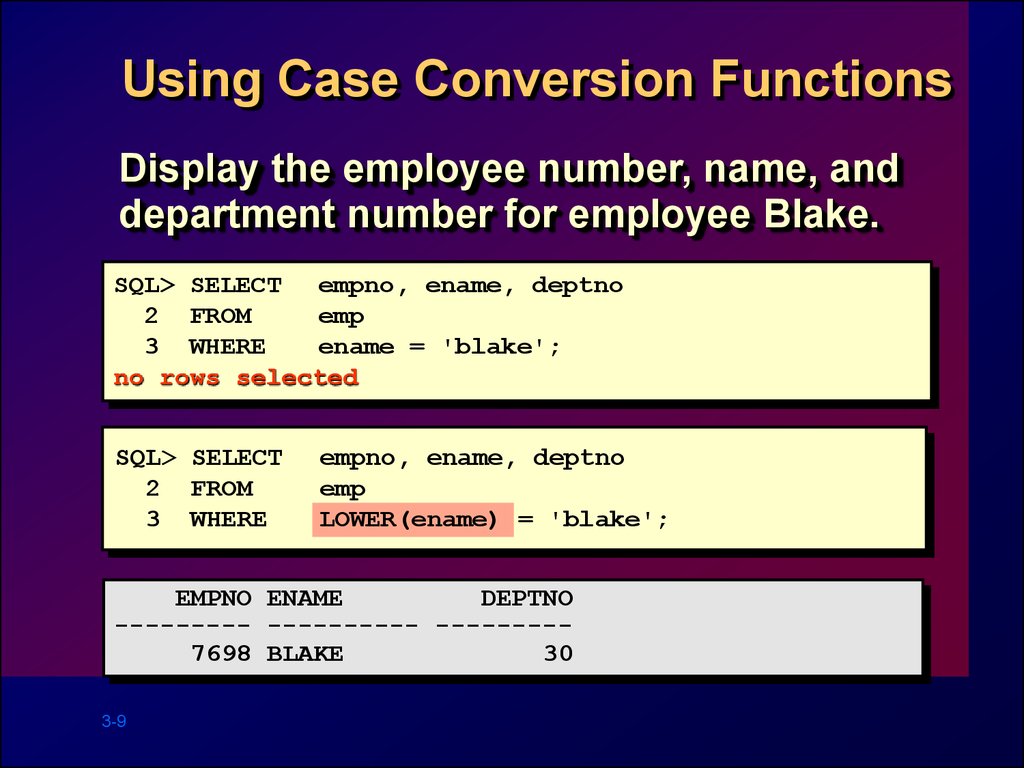
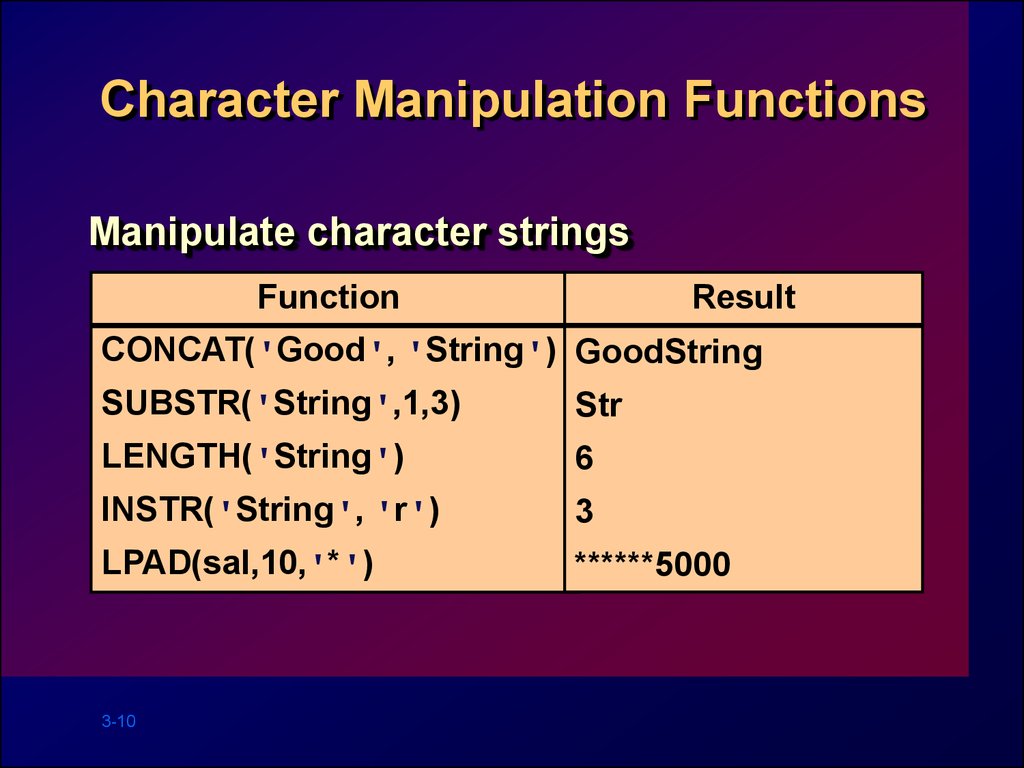
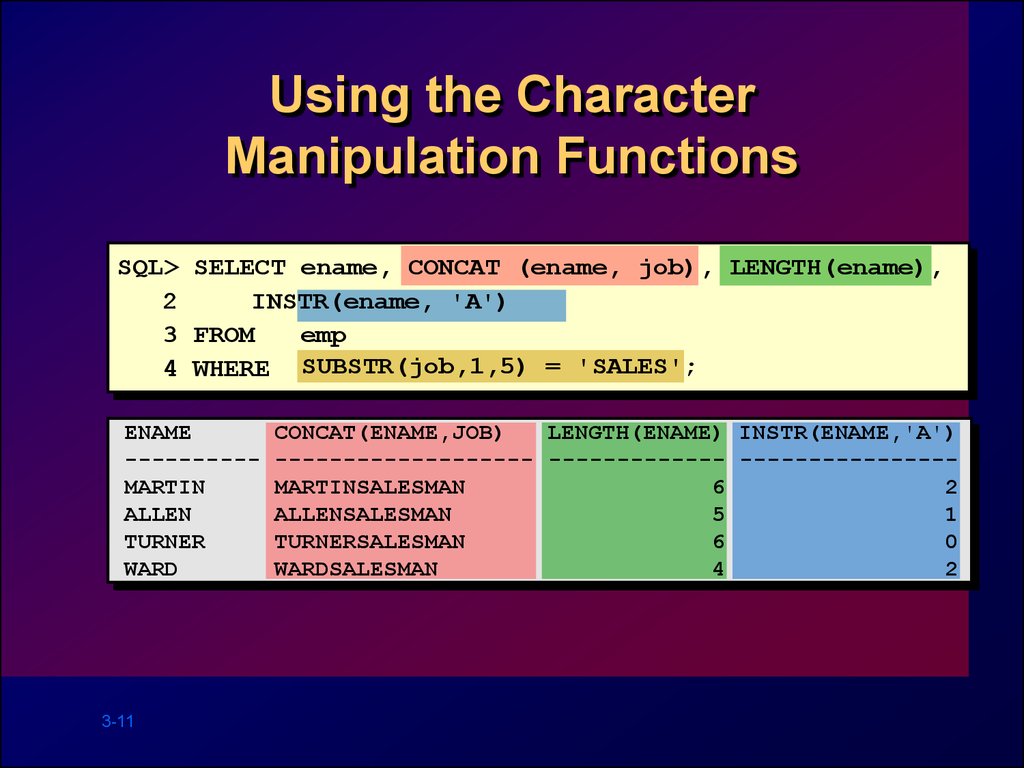
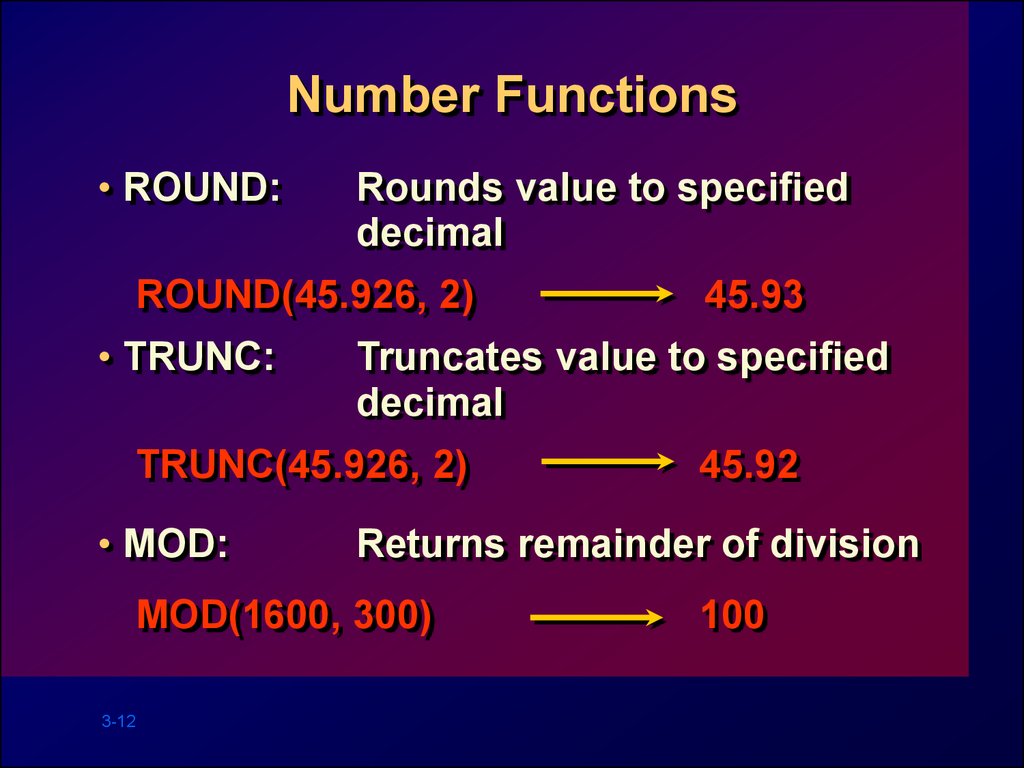

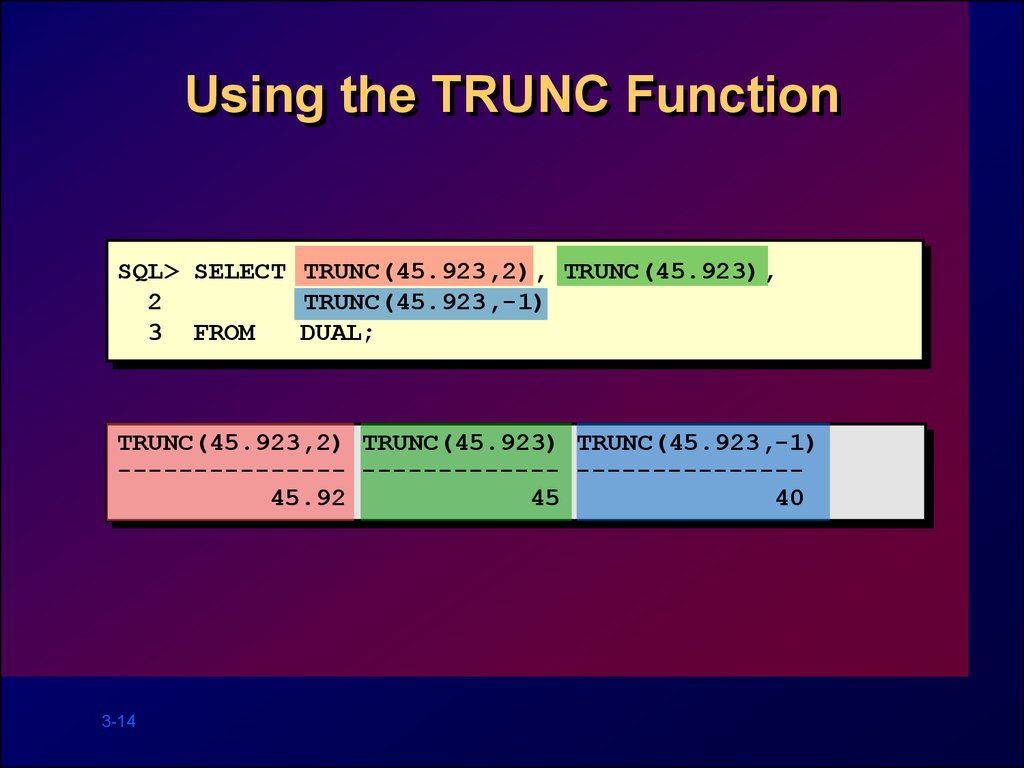
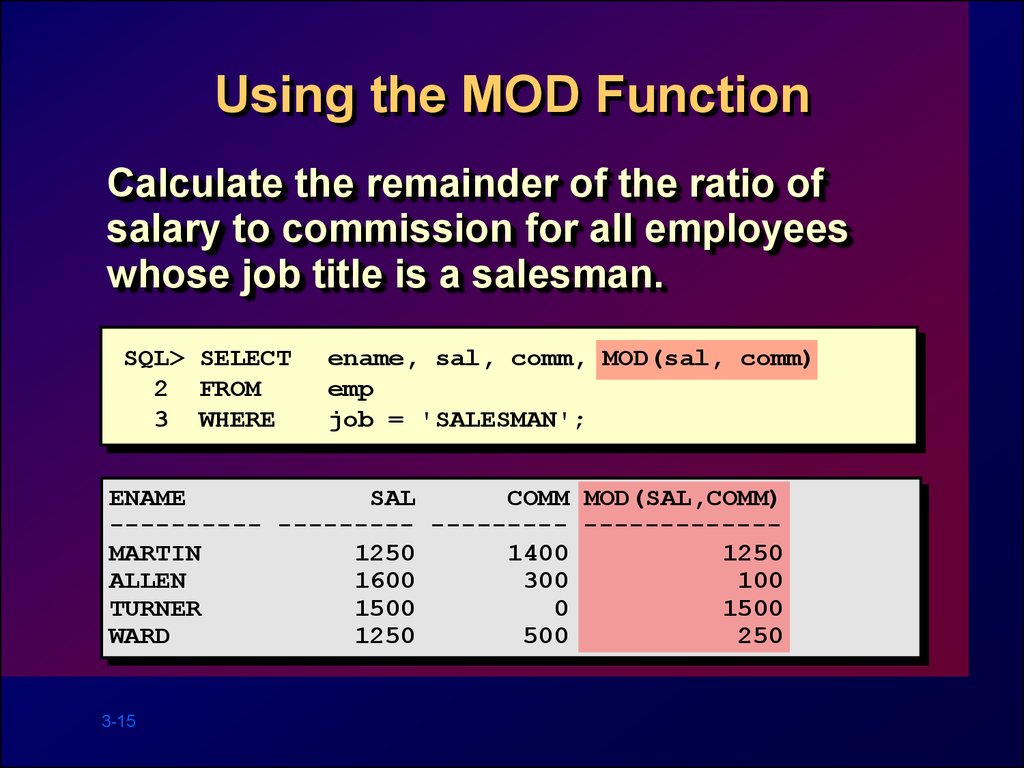
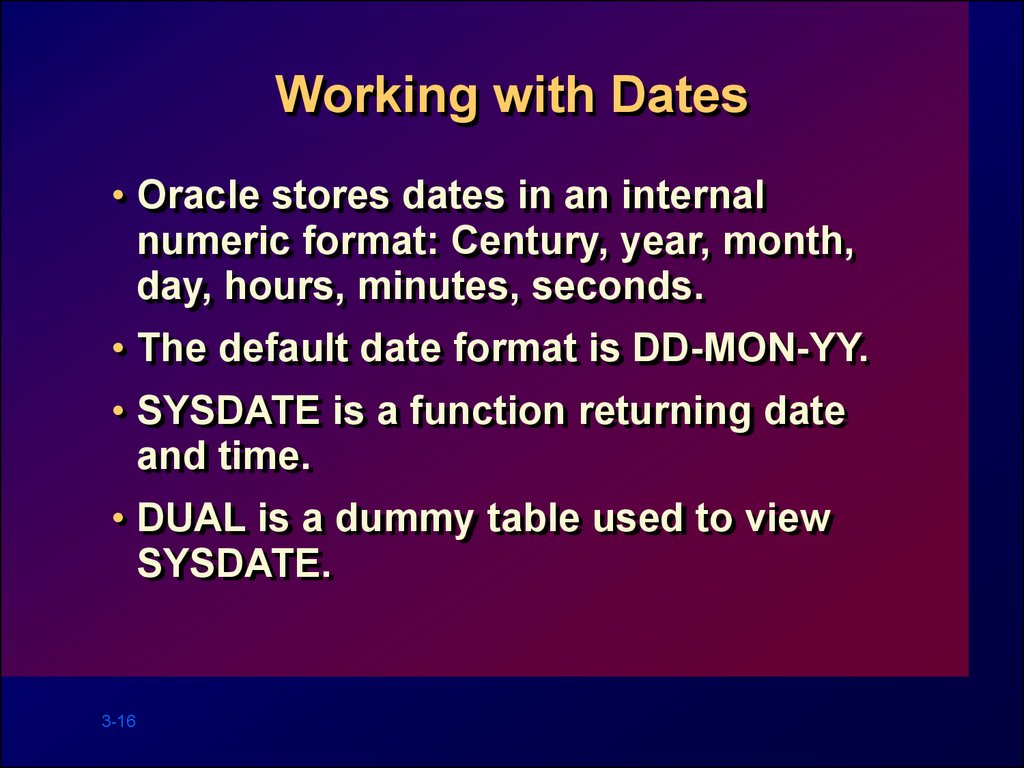
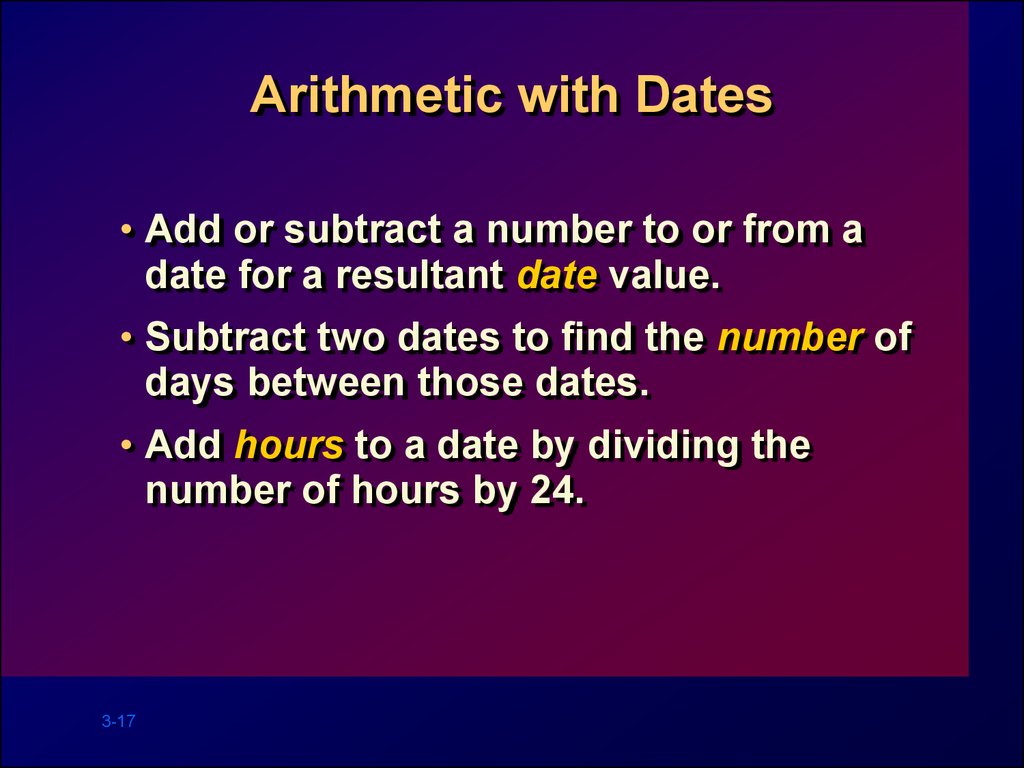
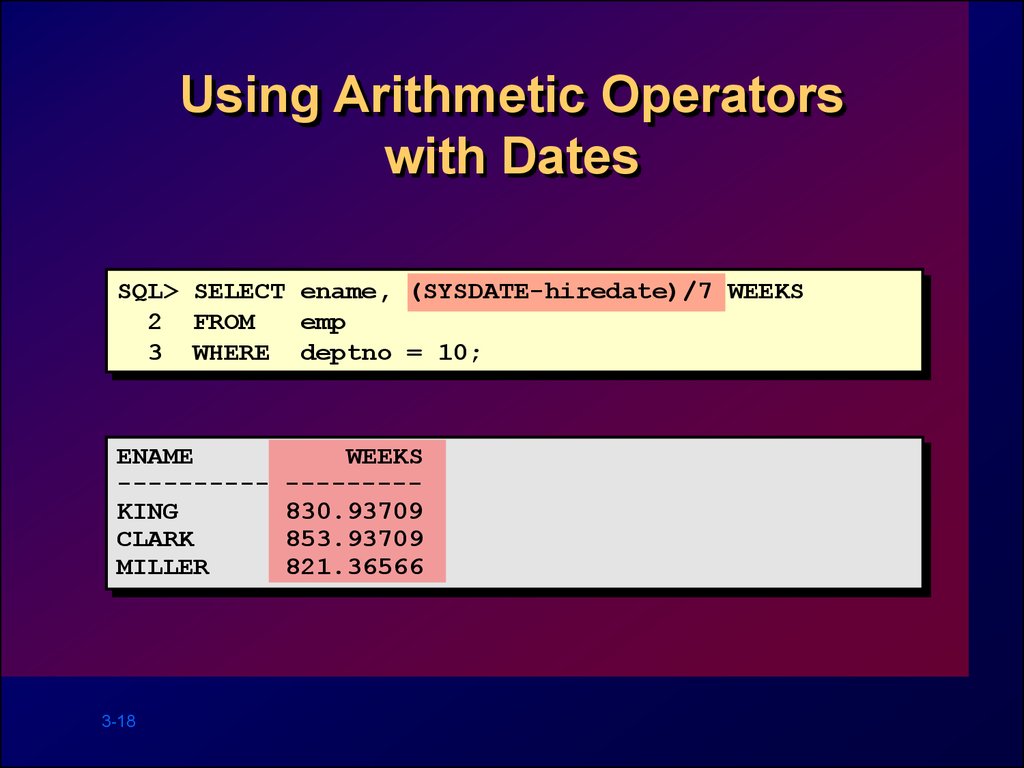
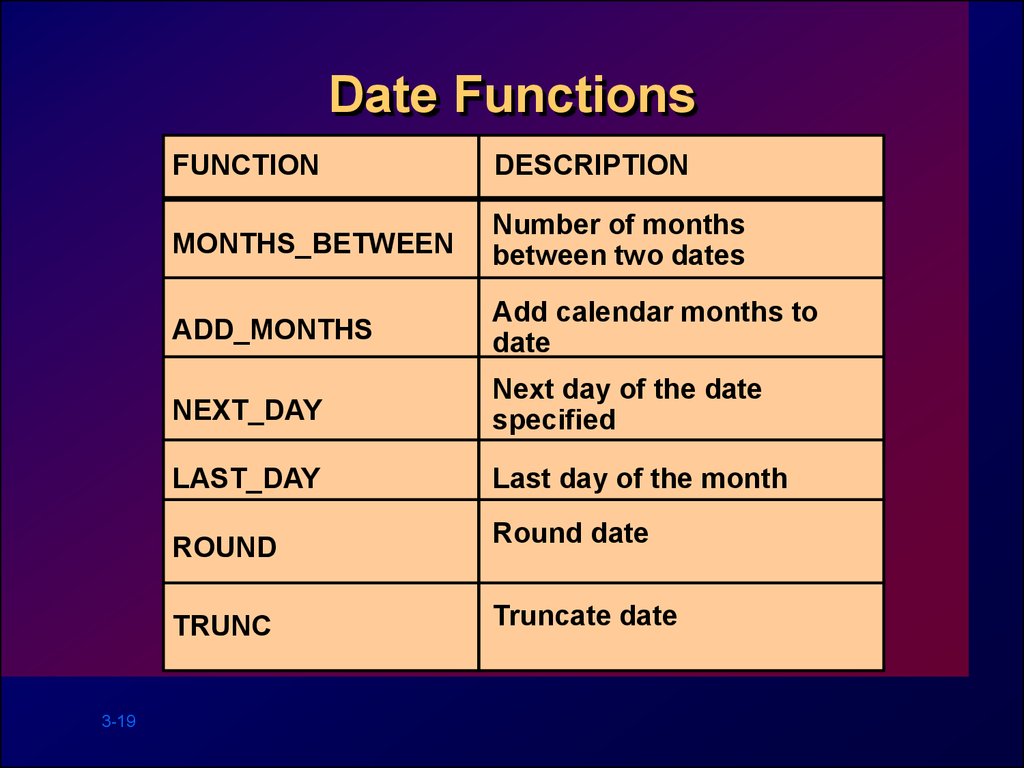
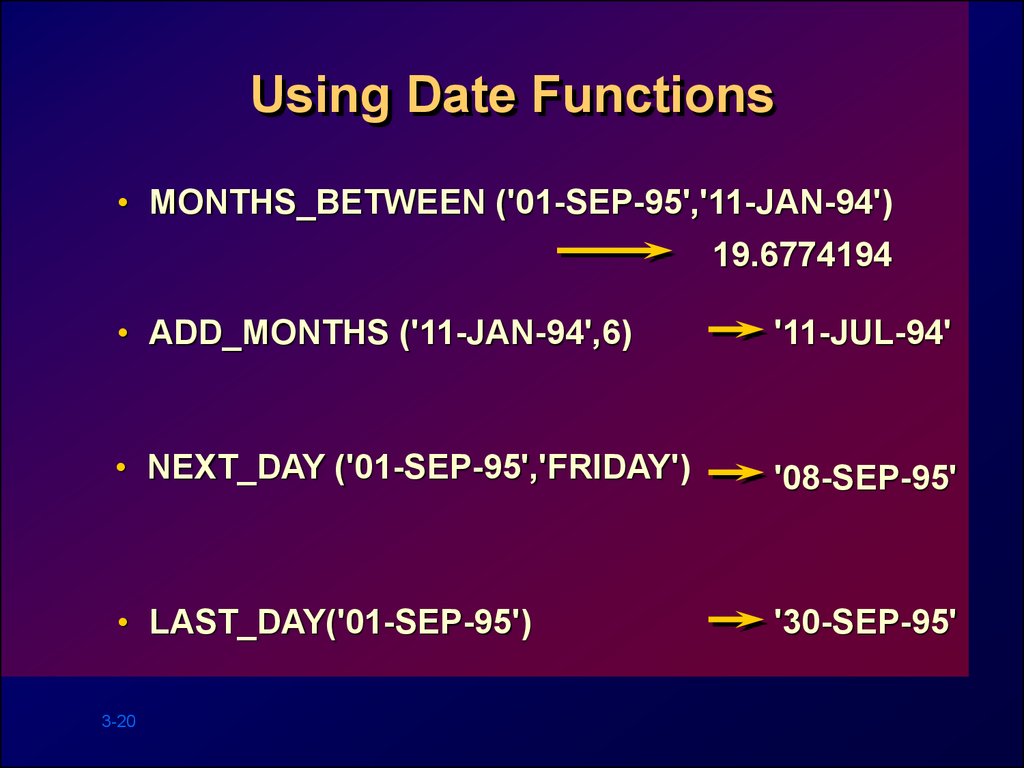
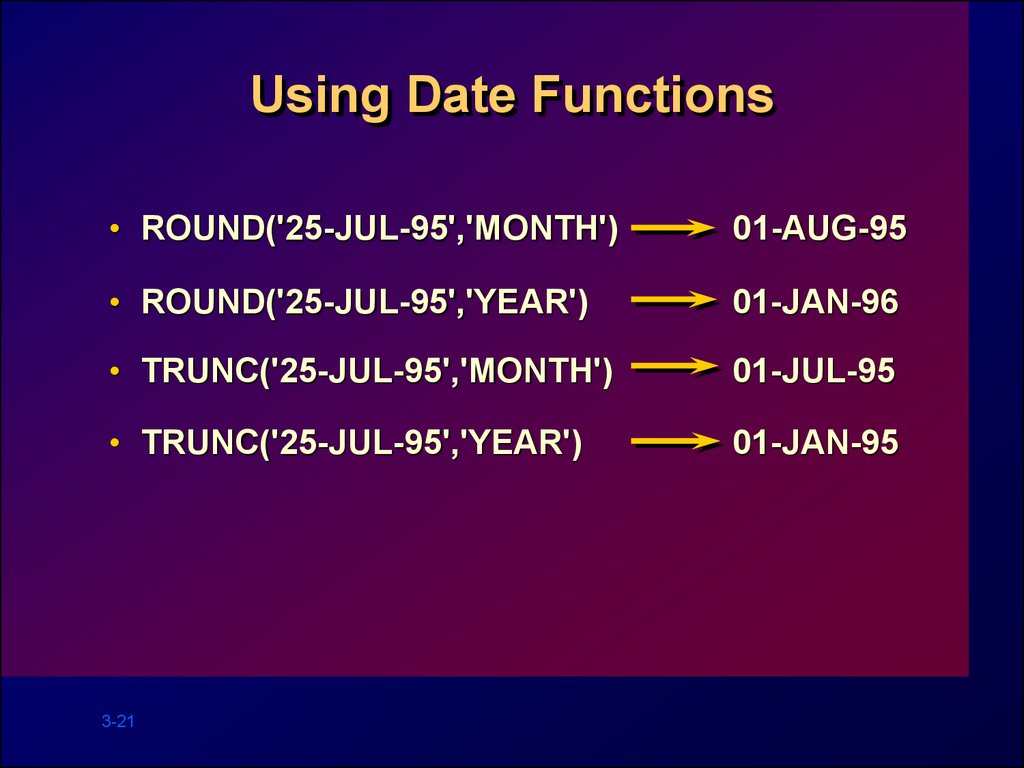
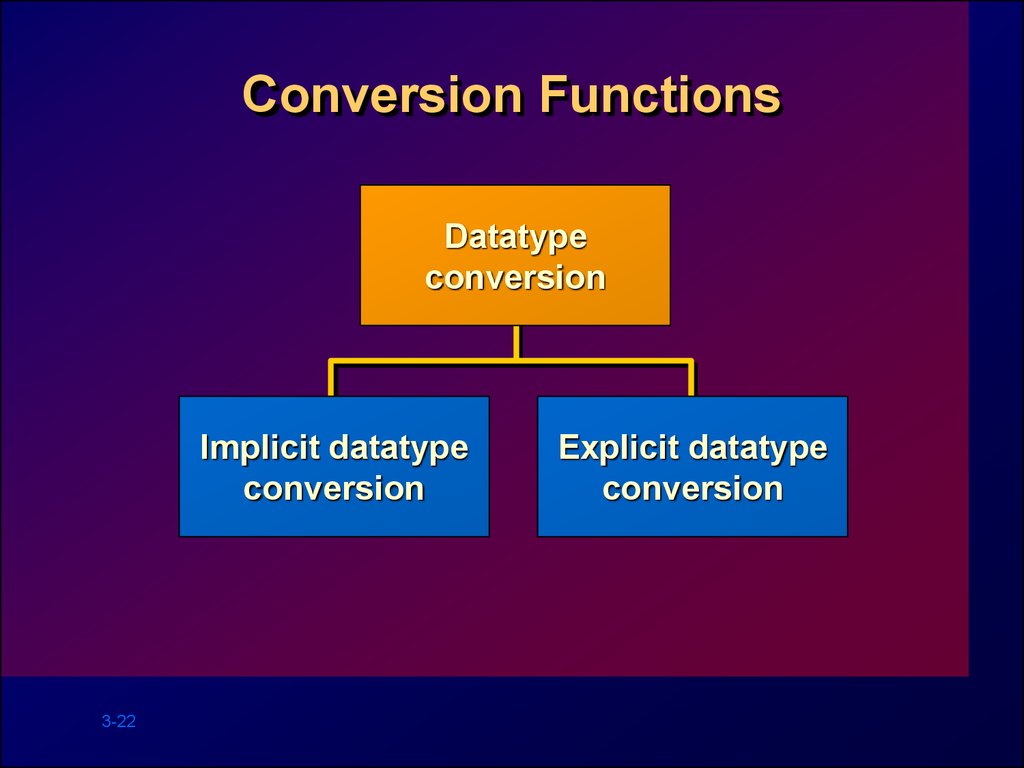
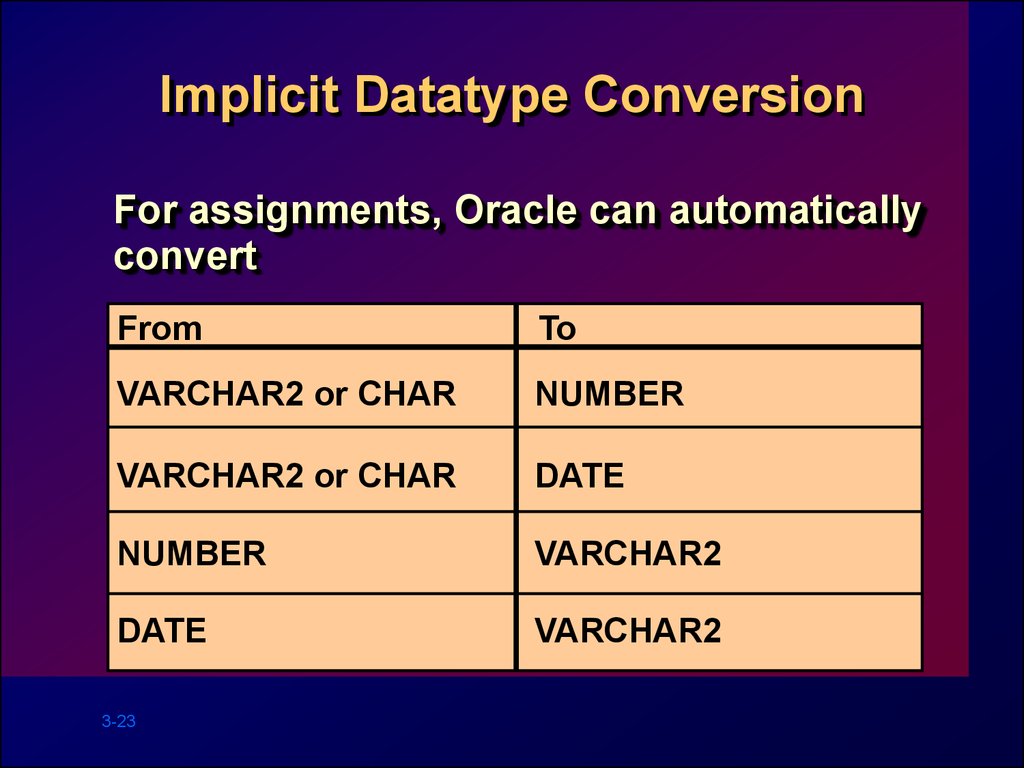

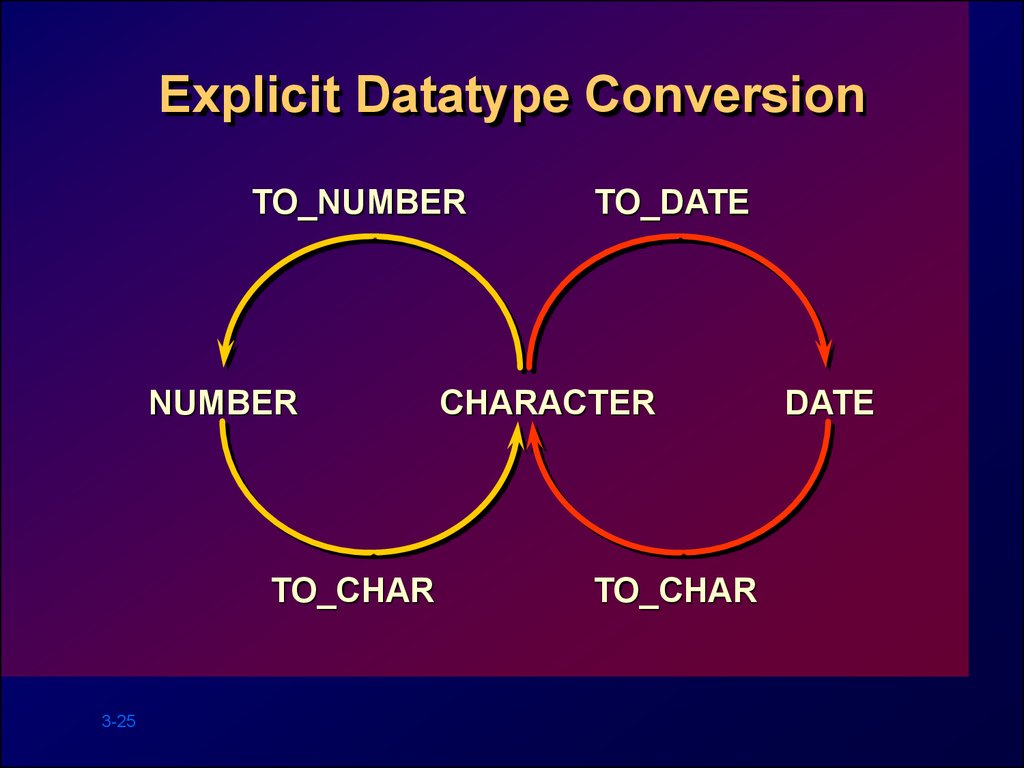

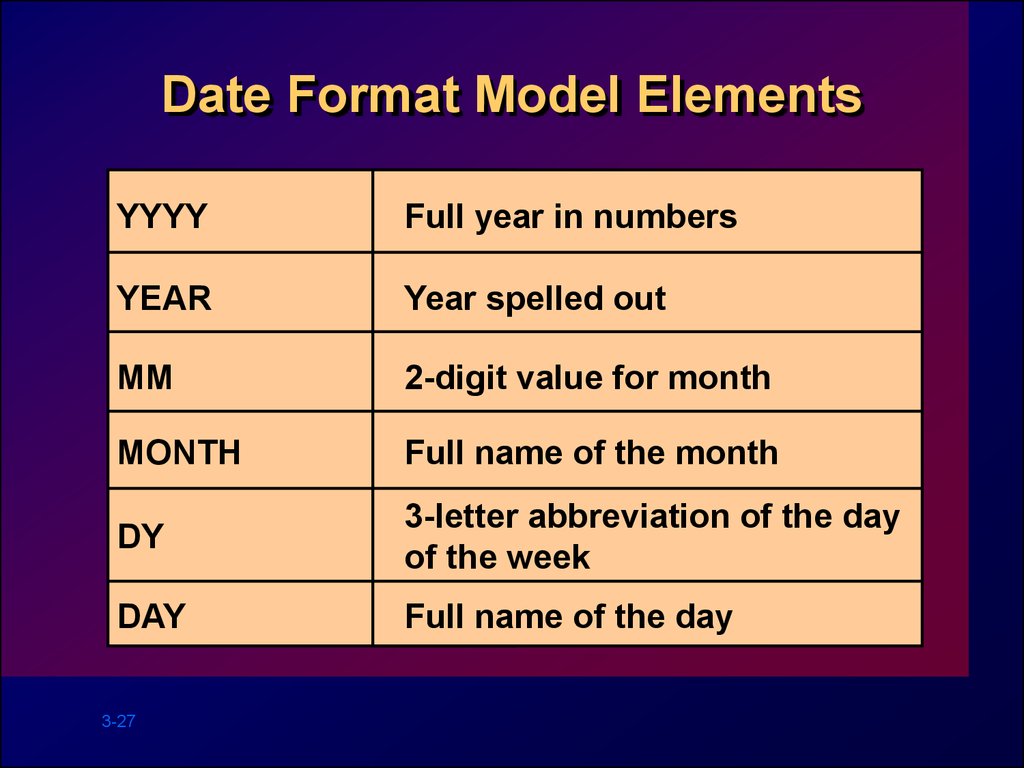
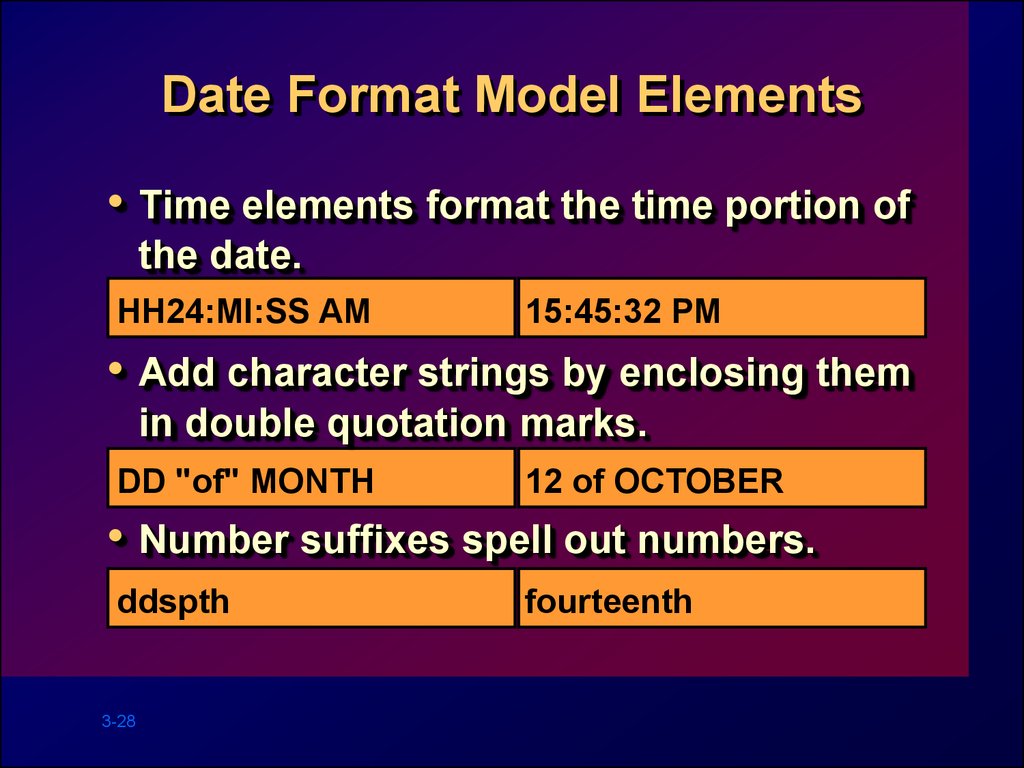

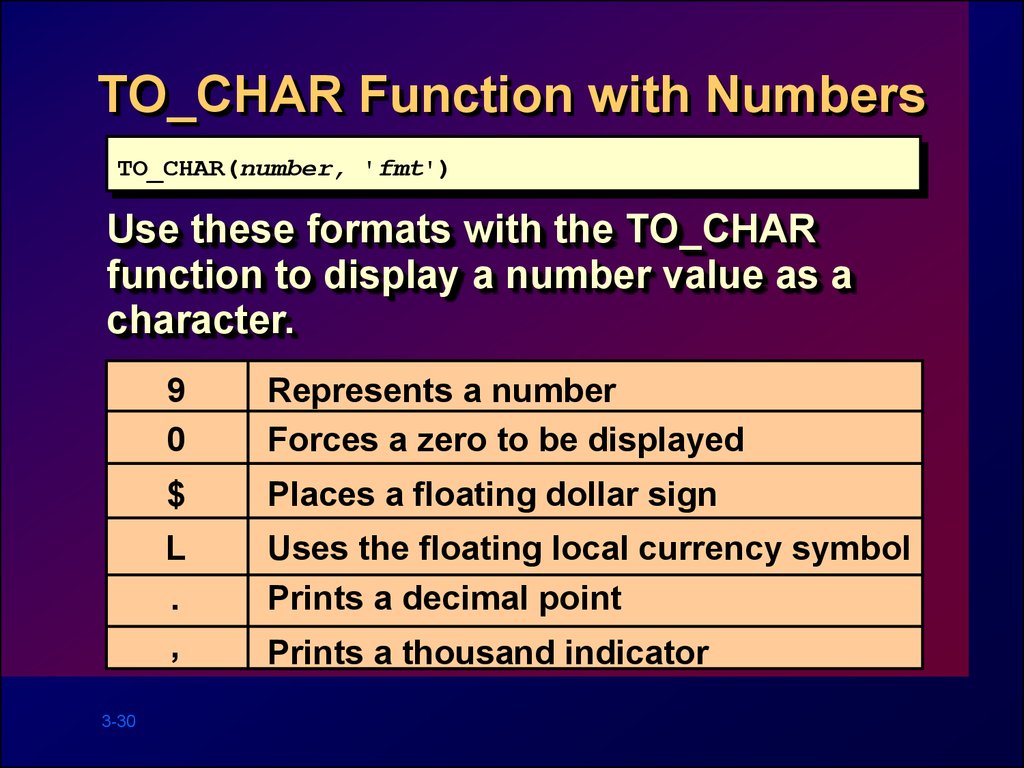
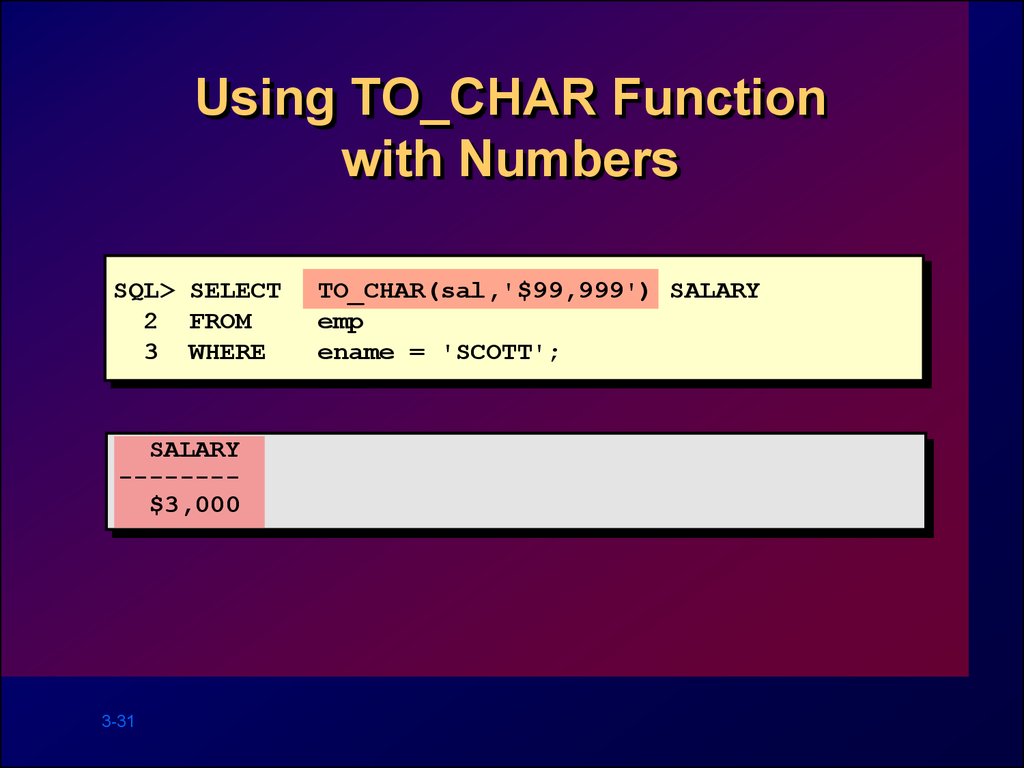
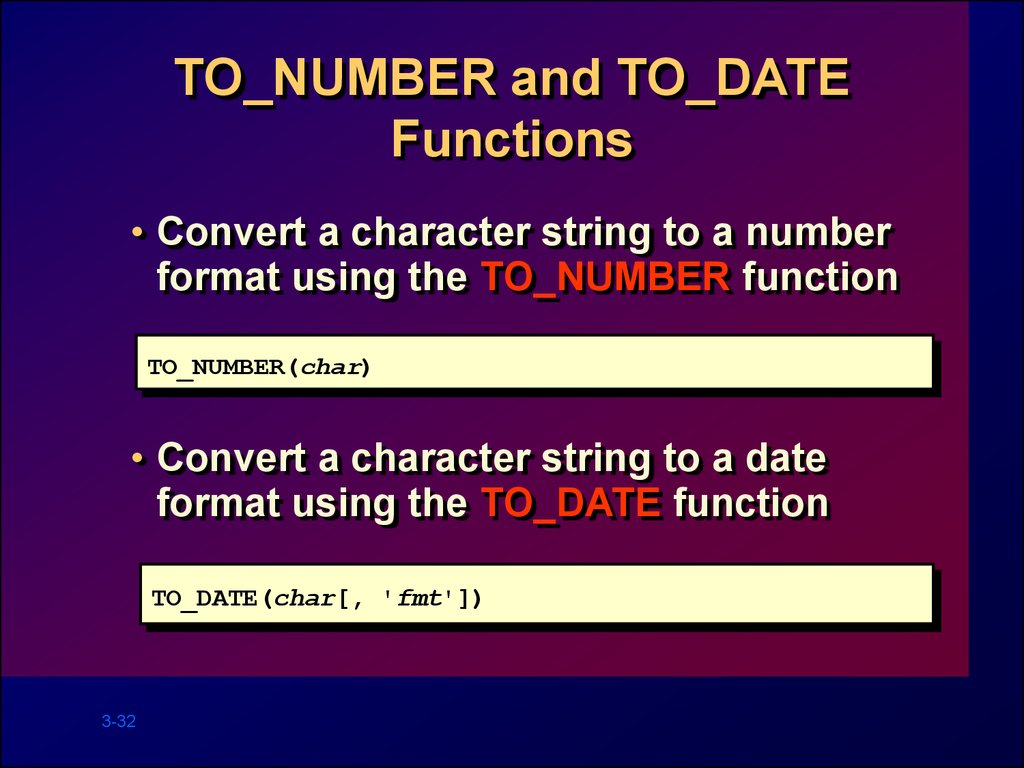
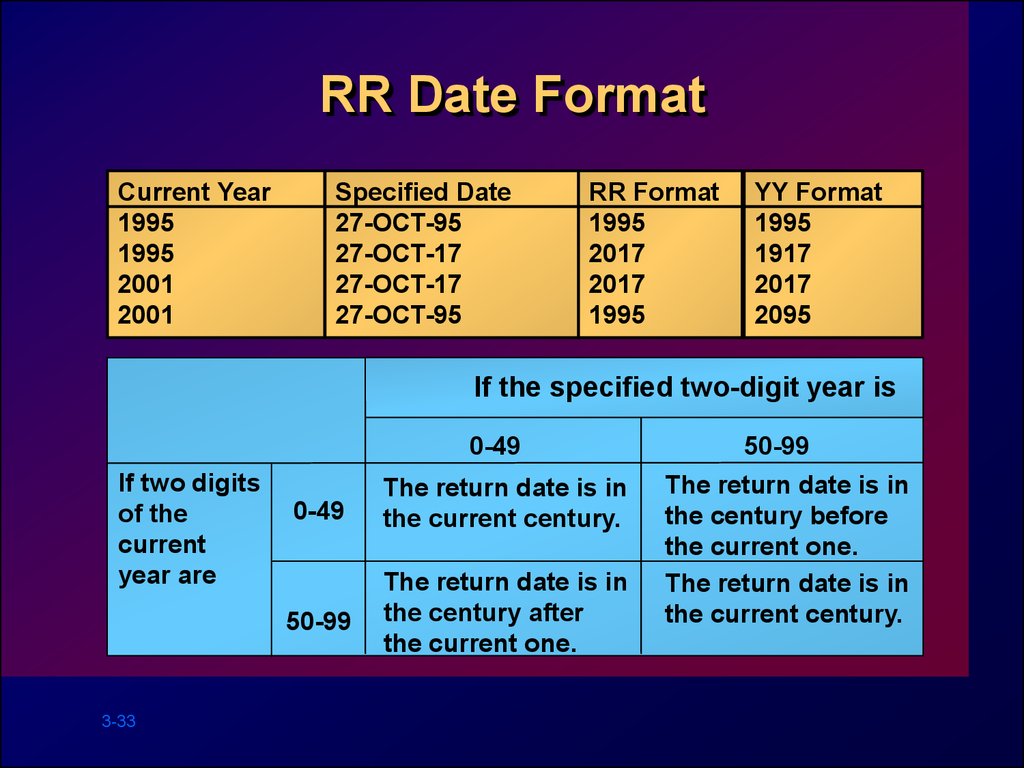
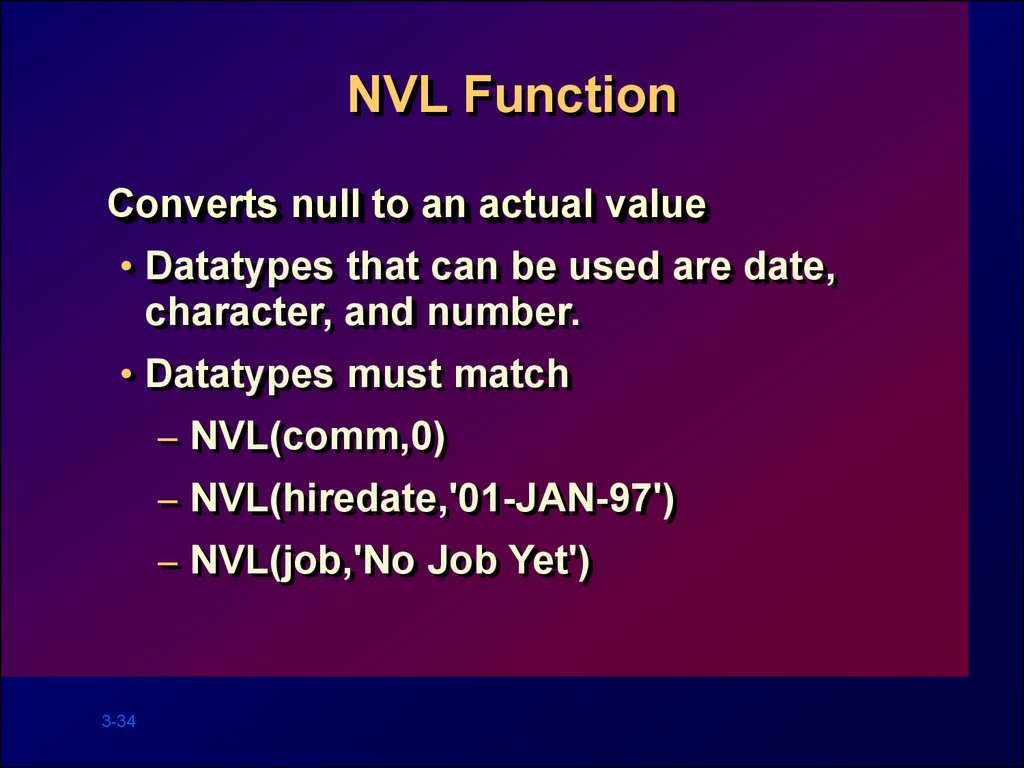
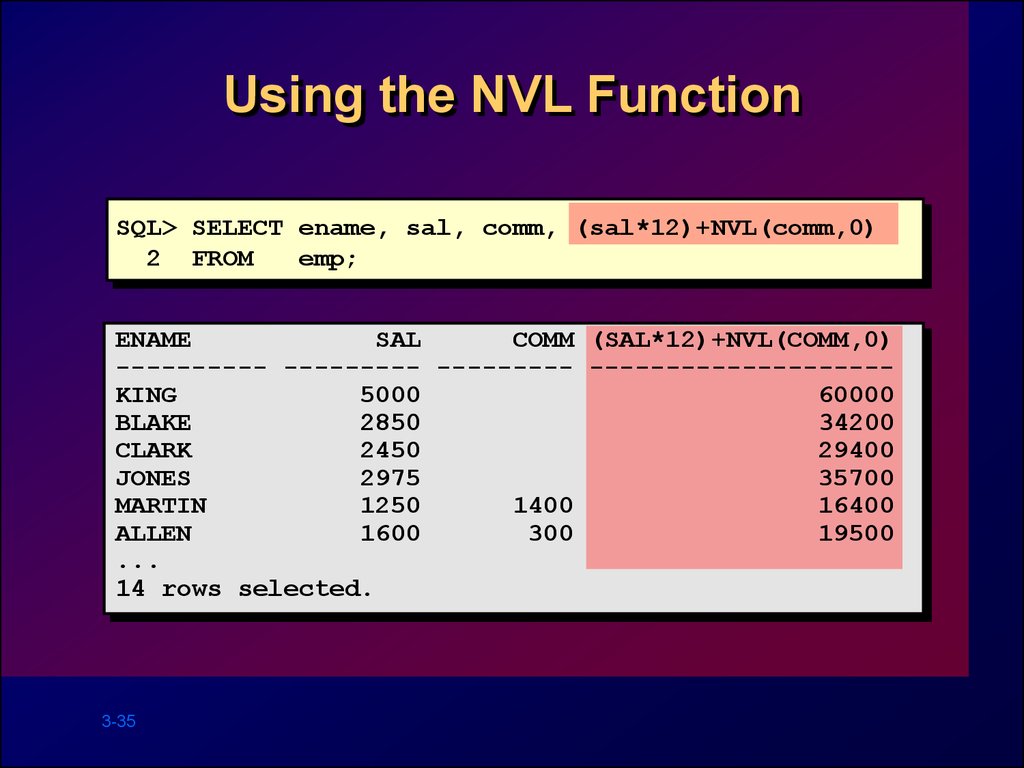

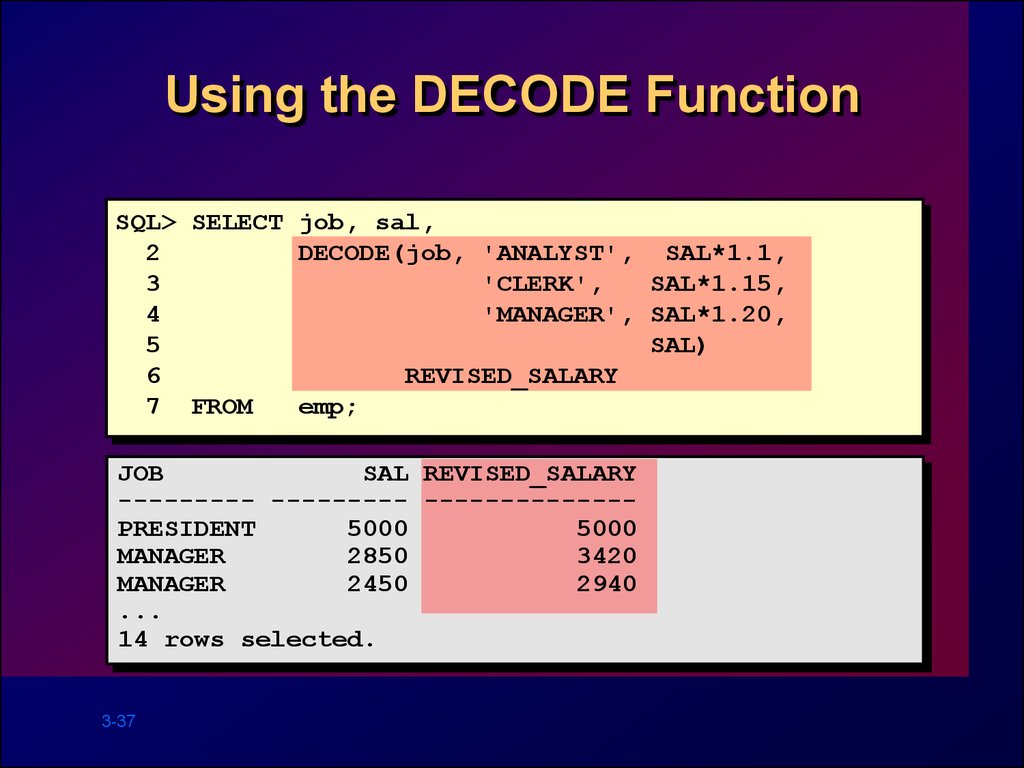
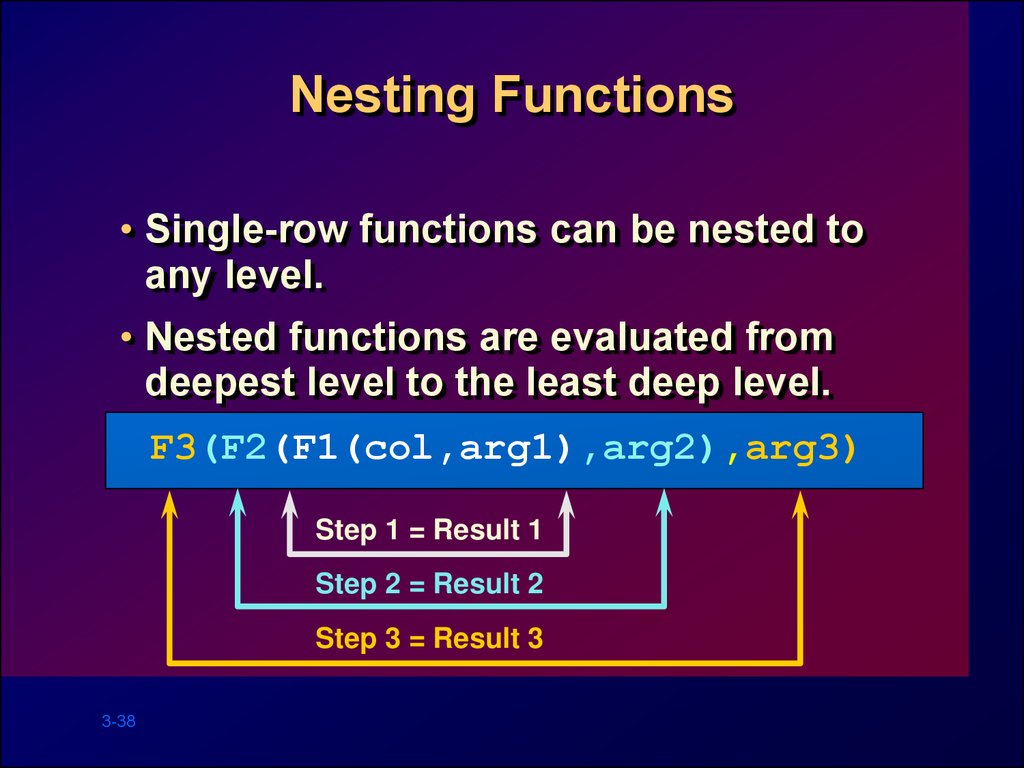

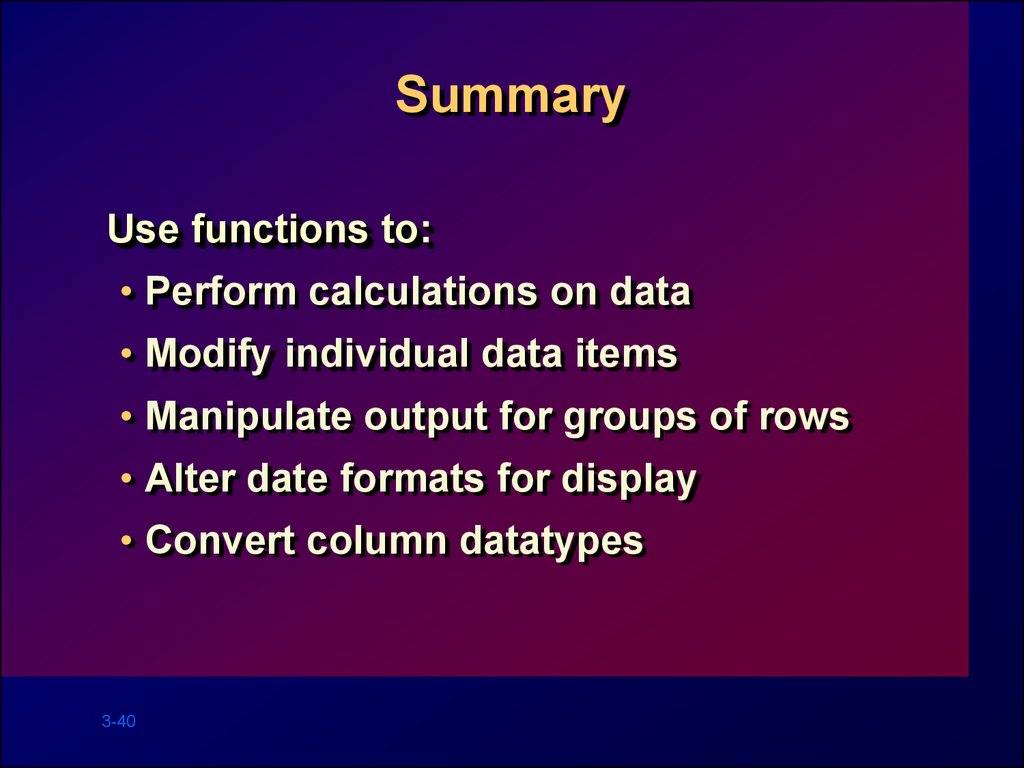
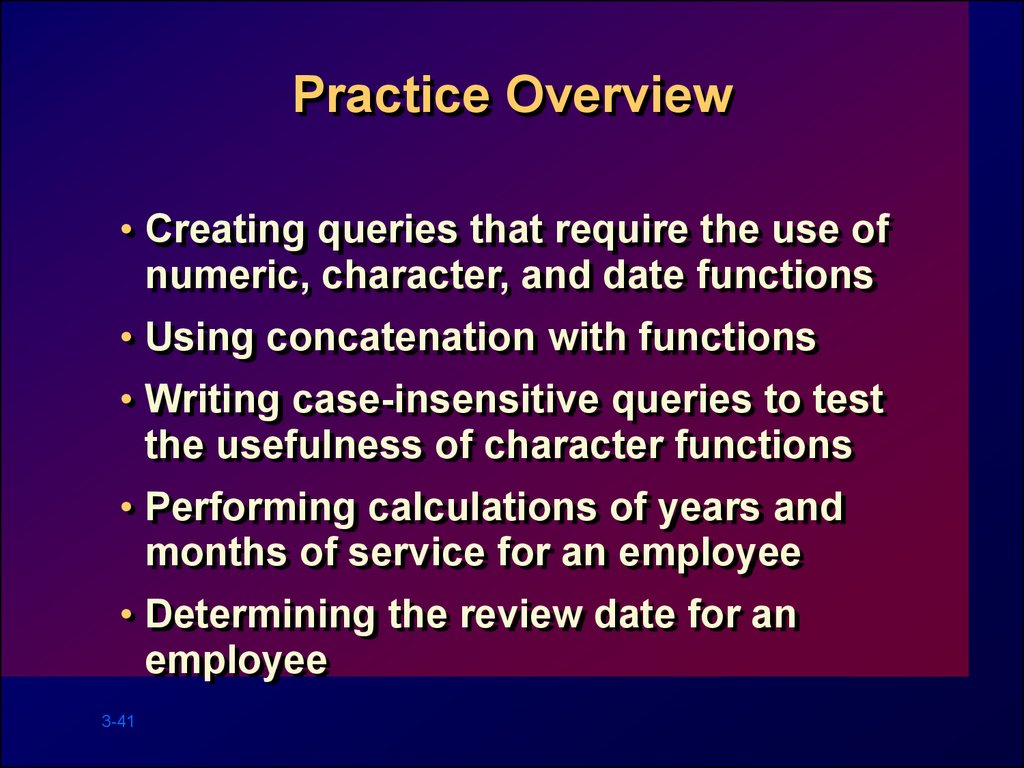

 Базы данных
Базы данных








